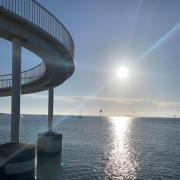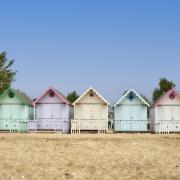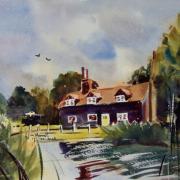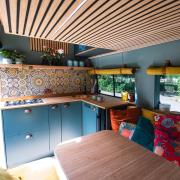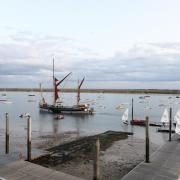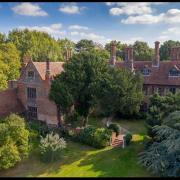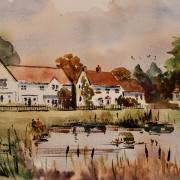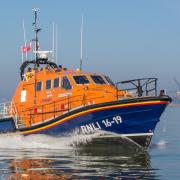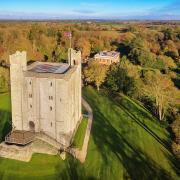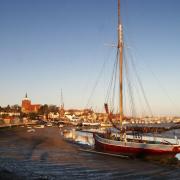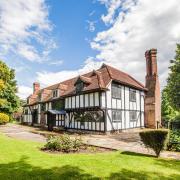Early in 2017, inspired by the railway posters of the 30s and 40s, I started illustrating some of the lighthouses along Ireland’s south coast. This quickly grew into a collection that culminated in a best-selling book, the Lighthouses of Ireland. During this time, I spent a holiday in Cornwall which spurred me to consider painting some of the lighthouses on the Cornish and Devon coastlines. Before you knew it, I was pouring over maps from Somerset to Scotland.
The collection now runs to over 350 lighthouses. They are available to buy as signed prints lighthouseeditions.com and a selection of these will appear in my new book, Legendary Lighthouses of Britain, which will be published by Watkins in early 2024.
While at their core, these structures are simply towers and beacons, our lighthouses have captured the imagination in a way that few other buildings have. Maybe it's the idea of strength and resilience, providing a guiding light in the darkness, that feels so relevant in our challenging times, but everyone seems to have a favourite. The lighthouse represents a unique piece of our maritime history and an aesthetically pleasing part of our built heritage. Long may they continue to shine.

Harwich High and Low Lights
In 1665, two lights were displayed in Harwich to help navigation into the river Stour. One was installed on top of the old town gate and consisted of a coal-fed brazier. The other was a much simpler affair; just a basic seven-metre tall wooden frame tower with a candle displayed from its top. The lights were soon securing a fortune for their owner, Sir William Batten, as not only were vessels bound for Harwich and the nearby ports required to pay dues but also those simply passing along the coast. The lights were found, however, to be inadequate and feeble, and though pressure was put on the Commissioners to ensure they were upgraded, little by way of improvement occurred for over a century and a half. By the time General Francis Slater Rebow, who was distantly related to Batten on his mother’s side, was granted a patent in 1816, it was on the proviso that two new towers be built, the equipment improved and that he contribute a percentage of his profits towards the upkeep of the church and street lighting in the area.
By 1818 the two towers were complete and the lights were displayed using oil lamps and reflectors; nine in the high lighthouse, three in the low. The high light, initially displayed from a window halfway up the tower quickly proved inadequate. Instead, the light was moved to the top of the tower and the apparatus increased to ten burners, giving it an improved range of 21km. The low light, designed by John Rennie stands 16.5 metres tall and is a ten-sided brick structure. The canopy was added in the late 19th century to provide shelter for walkers on the seafront. The lighthouse now houses the Maritime Museum.
In 1836 Trinity House eventually bought out the Harwich Lights lease from General Rebow. The continued movement of shingle off Landguard Point, however, had caused the river channel to migrate further and there was little to do but decommission the station. By this stage, the towers had earned the moniker of 'the misleading lights of Harwich!'

Dovercourt High and Low Lights
The two lights at Harwich were swiftly replaced by two equally intriguing structures at Dovercourt. What could, on a foggy morning, easily be mistaken for some retro alien spacecrafts, are in fact two, prefabricated leading or range lights, originally designed so they could be moved if the course of the channel shifted and are connected by a causeway that can only be accessed (with care) at low tide. An external ladder leads to the first floor housing and living quarters. From there, the lantern is reached by way of an internal ladder. The lights were originally powered by gas, giving the high light a range of 18km and the low light a range of 15km. Accommodation for the keepers was spartan, consisting of a small living room, a stove for cooking, toilets and a bunk bedroom. The lights were eventually retired in 1917 and Trinity House sold the structures six years later to Harwich Town Council with the proviso that they would be demolished should they decay to such an extent that they became unsafe.

Naze Tower
Perched on the low cliffs of the Naze nature reserve on the most easterly stretch of the Essex coast is a Hanoverian-style tower, more commonly referred to simply as Naze Tower. It was built by Trinity House in 1720 as a navigational mark to aid vessels plying the coast. During the Napoleonic wars, it served as a lookout and signalling tower and was subsequently used by the Royal Navy for practising semaphore and manoeuvring at sea. During 2004, extensive renovations were carried out and visitors can now climb the 111-step spiral staircase to the top of the tower and enjoy a 360-degree view of the beach and countryside. The Naze Tower features a museum with exhibits about the tower, the ecology and geology of the Naze, and coastal erosion in the area. The tower also features a private art gallery on six floors that showcases changing exhibits several times a year, and a tea room.

Gunfleet Lighthouse
Further down the Essex coast, six miles east of Frinton-on-Sea, lies Gunfleet Lighthouse, a derelict screw-pile lighthouse forlornly adrift, if going nowhere, on the flat grey expanse of the North Sea. Constructed in 1850, the 23m high structure is hexagonal in plan and mounted on seven piles forming a steel lattice and was originally painted red. It was first lit on May 1 1856, replacing a light vessel which had been on station there for the previous six years.
When in use, the lighthouse was staffed by two keepers. They were accommodated in a single-storey dwelling, immediately below the lantern, which was divided into a living room (also used as a kitchen), a bedroom and an oil room (in which the fuel for the lamps was stored). The walls and roof were made of corrugated iron, with wrought iron angle plates. Additional storage space was provided in the ‘inverted pyramid’ beneath the dwelling, which was accessed by a ladder from the gallery. What life must have been like for the keepers in this damp, cramped inverted garden shed, I can only imagine! The light and fog signal continued to be listed as active into the 1940s, but by 1951 it had been decommissioned. It remains in use as an automated weather station by the Port of London Authority and marks the northern limit of their jurisdiction.






